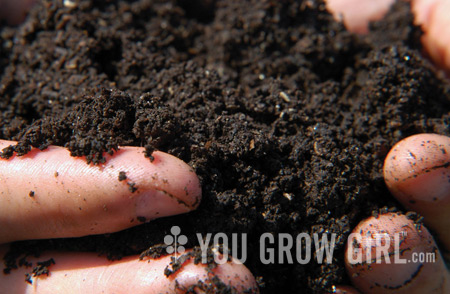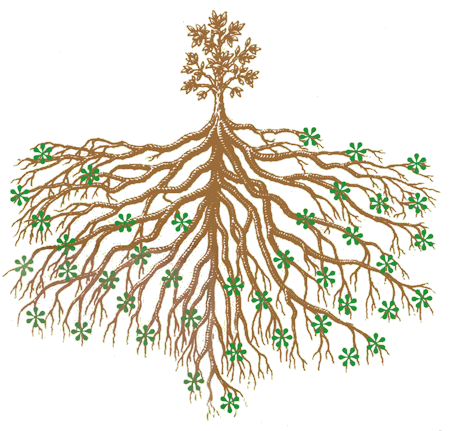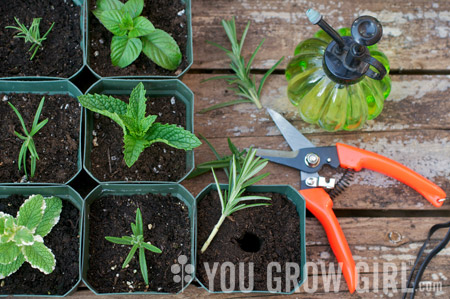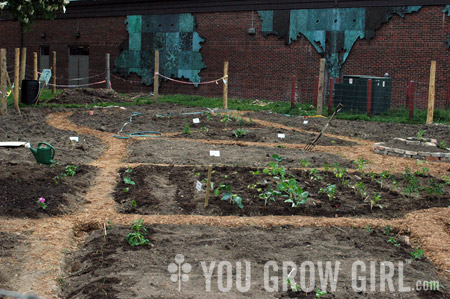
Let’s talk about fungi.
I first heard about mycorrhizae — pronounced my-corr-rye-zuh and literally translated to mean “root fungi” — about 8 years ago while I was travelling to promote my first book. At an event in Oregon, a fellow speaker gave a presentation on the mutually beneficial relationships that are forged between fungi and plants, both above the ground and in the soil. I regret that I only caught the final minute or so of the talk, and to this day I can’t recall his name, but the seed was planted in my brain. Fungi are more than just another organism doing its own thing out in the big bad world. They can (and do) form cooperative communities with other organisms, including plants.
And then it sat there quietly waiting in the background for 7 long years.
It must have been intimidation that caused me to avoid pursuing it, because it wasn’t disbelief. In many ways, the basic principles behind the way that mycorrhizae acts in the garden closely resemble my own personal journey with holistic healthcare. Rather than treating each symptom individually, an holistic approach to wellness takes the whole system/being into account and seeks to address the root cause of the problem in order to restore balance and harmony. These experiences with holistic health have had a profound effect in how my approach to gardening has evolved over the last decade or so. It has been a time of great learning and my commitment to looking at the bigger picture has been strengthened by the anecdotal evidence that I observe in my gardens each year.
While I have placed a great deal of emphasis on the importance of soil health, I will also admit that it is complicated stuff — or at least it feels complicated. There is an entire living world below the soil surface that is as complex as the one above. There is so much to know and understand about what is going on down there and how it effects what takes place up here. When all is said and done, what I know and truly understand amounts to almost nothing at all. That thought is sometimes overwhelming.
 Illustration of mycorrhyizae is courtesy of Bio-Organics.
Illustration of mycorrhyizae is courtesy of Bio-Organics.
This year, Bio-Organics, one of several companies that has commercialized the use of mycorrhizae in the agricultural industry, came on as a sponsor of this site and the timing could not have been better. Suddenly I had the push that I needed to really dig in and research this stuff. 2013 will mark my third spring in my newest garden. In the first two years, I added loads of organic compost and duck manure into the sandy soil in order to improve its texture and nutritional value, generally making it a more amenable place to grow healthy crops. I have also added other slow-actng organic nutrients here and there, depending on the plants. That said, while things have gone rather well, I’ve felt that there was more that I could be doing. This is where mycorrhizae comes in. While the stuff is not cheap (another factor that has kept me from pursuing this further), it promises to restore and promote a healthy ecology to the soil and in turn, reduce my future dependancy on inputs such as expensive store-bought organic fertilizers.
What is Mycorrhizae and How Does It Work?
Healthy soil is rich and alive, full of beneficial bacteria, fungi, protozoa, and a host of other living organisms, some of which interact with plants (in a mutually beneficial way) to help keep them happy and thriving. Mycorrhizae specifically are fungi that attach to plant roots and absorb carbohydrates produced by the plants. In turn, they develop an extensive network of thin tubes that dig deeply into the soil and extract nutrients and water that is then used by the plant. A cooperative, symbiotic relationship is formed!
What the Relationship Does
The application of mycorrhizae to poor and even dead soil is purported to correct a host of systemic problems including:
- Increases drought resistance and tolerance. The mycorrhizae help to make more water in the soil available to the plants.
- Helps plants take up nutrients that are already present in the soil. Phosphorous uptake is said to be the most increased by the addition of mycorrhizae.
- Helps plants defend against some diseases.
- Helps plants develop stronger root systems.
- Contributes to higher yields in food crops.

While I am very interested in what the application of mycorrhizae can do in terra firma, I was especially intrigued by an article that mentioned its application in developing healthier seedlings and potted plants, too (it never occurred to me that it would work there as well). Interestingly enough, this seems to be a popular and widely lauded commercial application of the product/s. In the article, “Mighty Mycorrhizae” (see Resources below), mycorrhizae, when applied to potting soil help to “…get the last bit of nutrients out of the pot and the fungi will defend the roots from diseases encouraged by overwatering.” The powdered form is also dusted directly onto seeds, cuttings, and transplants before planting to aid in the development of stronger root systems from the get-go and, in the case of transplants, prevent shock.

Mycorrhizae for Urban and Container Gardeners
This season I am planning to test mycorrhizae across the entire spectrum of planting including seed starting, houseplants, outdoor container plantings, and a few raised beds (I will leave some without for testing). I asked Graham Phillips of Bio-Organics a few questions around its use in container plantings specifically, and was encouraged by what he has to say on the subject.
Q: Most home gardeners are familiar with inoculation as it applies to dipping their pea seeds into Rhizobia bacteria to help improve yields. Is this concept similar to inoculating peas and other legumes?
Graham: This is very similar. In fact many people mention this. It is adding biology to the soil to improve plant performance. Have you used rhizobia bacteria as an inoculants? If so, which has worked best? Also, it is important to remember that mycorrhizae will not form on mustard or brassica plants so our inoculants and the mycominerals will not work with those crops (but will work with 95% of plants).
Gayla: To answer Graham’s question, I have been using rhizobia bacteria as a pea inoculate for many years. I do this with peas and not other legumes because I am often starting them early in the spring when the soil is still quite cold. I find they are most effective in increasing yields in container grown plants. The tricky thing is that it is a difficult product to find locally. I receive many emails each spring from people who want to try it but can’t find a seller. For that reason I have not had a chance to explore a variety of strains.
Q: While we organic gardeners try to do our best to approximate in pots what goes on in the ground, we still tend to see our outdoor containers and indoor houseplants as contrived, somewhat artificial environments. Can mycorrhizae help to create more holistic systems in containers as well as it does in terra firma?
Graham: Yes, that is often why growers use it in potting soil and raised beds. The MycoMinerals appeals here slightly more because of the trace elements it introduces as well as the biology. However, if a grower has a system for introducing those types of elements and other biology to containers, etc. then they would want to use the inoculants.
Q: I’m trying to determine the differences between your products and which is best for my growing conditions as an urban gardener. How is the Mycominerals product different from the mycorrhizal inoculants? When should I consider this instead?
Graham: The newsletter I recently wrote summarizes this: Basically we find that people with raised beds and potting soil tend to choose the MycoMinerals to introduce the trace elements, etc. as well as the mycorrhizal fungi, whereas the inoculants are very concentrated and are used to directly introduce the spores to the roots.
Q: Is it possible for a gardener to over-inoculate or apply too much? [Note: I was thinking about this in relation to fertilizers and how too much nitrogen at the wrong time can promote soft growth that attracts aphids, or it can encourage a lot of foliar growth that causes plants like tomatoes to put off producing fruit.]
Graham: No, you cannot over inoculate and could use as much as you want, but you would likely want to find the minimal amount (so as not to waste any) where you will still get colonization of the roots. Once that happens they will multiply at the roots.
Q: Can mycorrhizae help when starting a new garden in compacted, dead urban soil?
Graham: Yes, mycorrhizae does help soil conditions considerably. One reason is the mycorrhizae form hyphae [ed.note: the thin tubes I mentioned above] which begin to reach out for nutrients and break up the soil.
Here is a good newsletter article from Don Chapman on it.
Sources:
With so much to know and learn about mycorrhizal fungi, I have put together a list of the sources that I used as research for this article.
- Mycorrhizas and Mineral Acquisition in Grapevines by Paul Schreiner
- Mighty Mycorrhizae by Doreen G. Howard, in The American Gardner, The Magazine of the American Horticultural Society. July/August 2005. Pages 23-27.
- A Wharton grad hopes there’s money in fungus
- Mycorrhizal Effects on Host Plant Physiology
My friend Margaret Roach of A Way to Garden also wrote a piece on mycorrhizae, with a focus on its application and use in home vegetable gardens. You can read that here.
An Offer for Readers
Bio-Organics, an advertiser on YouGrowGirl.com, is offering a discount on products to my readers from now through midnight Sunday, March 17. Use the code spring15 (for 15% off) or spring20 (for 20% off orders over $100) at checkout. (Note: This is not an affiliate link, and I do not receive any commission on products purchased.) This season, I will be testing the MycoMinerals product in my raised beds and containers, but the EndoMycorrhizae is recommended for most garden uses. I’m getting the smallest jar — apparently a little goes a long way and this is plenty for small-average gardens. All products are listed for organic use. Unfortunately, due to customs restrictions, these products are not available for shipping to Canadian customers at this time. However, they are open to a number of other countries.
Have you used mycorrhizae in your garden? What has your experience been with it?
Mycorrhizae is something we have been selling and using now for quite a few years. I first learned about it from Monrovia Nursery, who started using it in their plants about 15 years ago. It’s now included in many potting soils, as well as a line of organic fertilizers.
I am surprised it cannot be shipped into Canada. I wonder what the thinking is? Can Monrovia ship plants into Canada that have it in the soil, or is it just the concentrated form that cannot be shipped?
I’m not sure exactly. The way it was explained to me, there is a registration process involved, but it is very costly and the process takes years.
But that’s for shipping the concentrated mycorrhizae specifically. Apparently there are some concessions around products that contain minerals since they are categorized as amendments/fertilizers.
I first heard about mycorrhizae through the company Espoma. I used their organic fertilizer, which contains beneficial microorganisms, and they also sell a mycorrhizae product. I think this could be really useful for clay soils as well.
I wonder if the speaker you heard was Paul Stamets – he’s written a few books on mushrooms and speaks at expos frequently.
Yes! That’s who it was.
In Russia we have little knowledge of mycorrhizas. There are several reasons. First, it is the mentality of people, focused on the use of chemicals in the soil and getting quick results. Secondly, the lack of advertising mycorrhizae manufacturers. And third, this resistance fertilizer producers. Mycorrhiza entered only once, and this is a direct threat to their interests.
I used a similar product last year on some newly built raised beds. Though I had incorporated our good topsoil with all its inherent microorganisms, I had also added potting mix to get up to the level of soil I wanted. I added the Thrive brand myco liquid, and it really did seem to help the soil retain moisture. I will be doing that again with this year’s new beds.